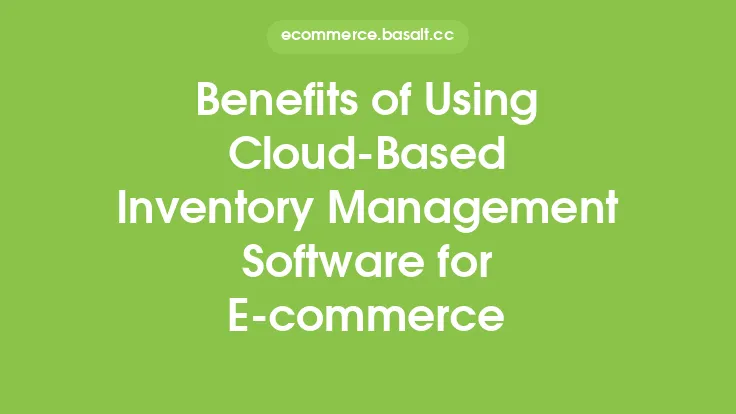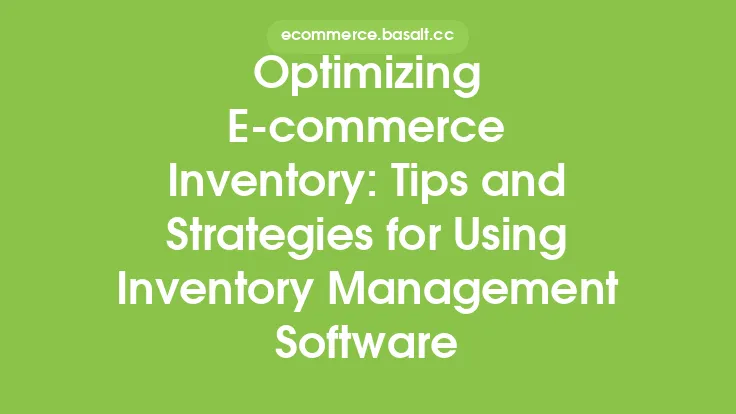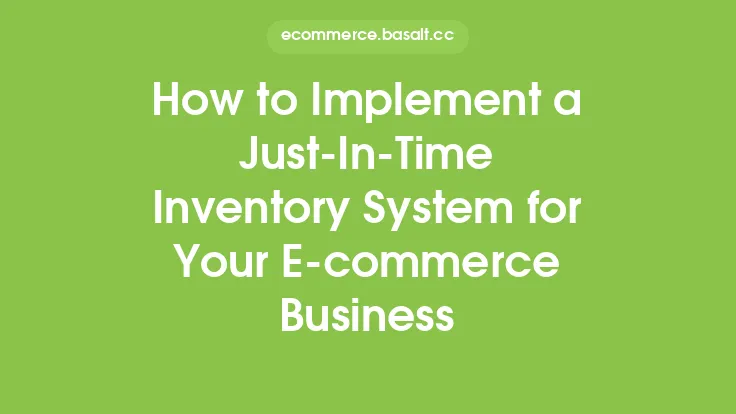In the world of e-commerce, inventory management is a crucial aspect of running a successful online business. One key strategy for optimizing inventory levels is the use of data analytics. By leveraging data analytics, e-commerce businesses can gain valuable insights into their inventory levels, customer demand, and supply chain operations. This information can be used to make informed decisions about inventory management, reducing the risk of overstocking or understocking, and ultimately improving the overall efficiency of the business.
Introduction to Data Analytics for Inventory Optimization
Data analytics for inventory optimization involves the use of advanced statistical and mathematical techniques to analyze data related to inventory levels, customer demand, and supply chain operations. This data can come from a variety of sources, including sales data, customer feedback, and supply chain metrics. By analyzing this data, e-commerce businesses can identify trends and patterns that can inform their inventory management decisions. For example, data analytics can help businesses identify which products are most popular, which products are likely to be in high demand during certain times of the year, and which products are at risk of becoming obsolete.
Benefits of Using Data Analytics for Inventory Optimization
There are several benefits to using data analytics for inventory optimization in e-commerce. One of the primary benefits is improved forecasting accuracy. By analyzing historical sales data and other metrics, businesses can make more accurate predictions about future demand, reducing the risk of overstocking or understocking. Data analytics can also help businesses identify areas of inefficiency in their supply chain operations, such as bottlenecks or delays, and make adjustments to improve overall efficiency. Additionally, data analytics can help businesses optimize their inventory levels, reducing the need for excess inventory and minimizing waste.
Key Metrics for Inventory Optimization
There are several key metrics that e-commerce businesses should track when using data analytics for inventory optimization. One of the most important metrics is inventory turnover, which measures the number of times inventory is sold and replaced within a given period. A high inventory turnover rate indicates that inventory is moving quickly and efficiently, while a low turnover rate may indicate that inventory is not selling as quickly as expected. Another important metric is days inventory outstanding (DIO), which measures the average number of days it takes for inventory to sell. A low DIO indicates that inventory is selling quickly, while a high DIO may indicate that inventory is not selling as quickly as expected.
Data Analytics Tools for Inventory Optimization
There are several data analytics tools that e-commerce businesses can use for inventory optimization. One of the most popular tools is Excel, which offers a range of advanced statistical and mathematical functions for analyzing data. Other popular tools include Google Analytics, which provides insights into website traffic and customer behavior, and inventory management software, such as TradeGecko or Zoho Inventory, which offer advanced inventory tracking and analytics capabilities. Additionally, many e-commerce platforms, such as Shopify or Magento, offer built-in analytics tools that can help businesses track inventory levels and optimize their supply chain operations.
Best Practices for Implementing Data Analytics for Inventory Optimization
There are several best practices that e-commerce businesses should follow when implementing data analytics for inventory optimization. One of the most important best practices is to establish clear goals and objectives for inventory optimization, such as reducing inventory levels or improving forecasting accuracy. Businesses should also ensure that they have access to high-quality data, including sales data, customer feedback, and supply chain metrics. Additionally, businesses should invest in advanced data analytics tools, such as machine learning algorithms or predictive analytics software, to help them analyze and interpret their data. Finally, businesses should regularly review and update their inventory optimization strategies to ensure that they are aligned with changing customer demand and market trends.
Common Challenges and Limitations
While data analytics can be a powerful tool for inventory optimization, there are several common challenges and limitations that e-commerce businesses should be aware of. One of the primary challenges is data quality, as inaccurate or incomplete data can lead to poor decision-making. Another challenge is the complexity of data analytics, as advanced statistical and mathematical techniques can be difficult to understand and apply. Additionally, data analytics requires significant investment in technology and personnel, which can be a barrier for small or medium-sized businesses. Finally, data analytics is not a one-time solution, but rather an ongoing process that requires regular review and update to ensure that inventory optimization strategies remain effective.
Future of Data Analytics for Inventory Optimization
The future of data analytics for inventory optimization is exciting and rapidly evolving. One of the most significant trends is the use of artificial intelligence (AI) and machine learning algorithms to analyze and interpret data. These technologies can help businesses identify patterns and trends that may not be apparent through traditional data analysis techniques. Another trend is the use of cloud-based data analytics tools, which can provide businesses with greater flexibility and scalability in their inventory optimization efforts. Finally, the increasing use of Internet of Things (IoT) devices and sensors is providing businesses with new sources of data and insights, such as real-time inventory tracking and supply chain monitoring. As data analytics continues to evolve, e-commerce businesses can expect to see even more advanced and sophisticated tools for inventory optimization, enabling them to make better decisions and drive greater efficiency in their operations.





